by Art Shay
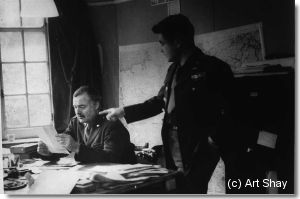
Hemingway & Shay © Art Shay |
(Swans - September 22, 2008) A respected filmmaker, alas not my friend and blurbist David Mamet, is making a documentary out of my latest book on Nelson Algren, the Chicago novelist with whom I wandered the underworld purlieus of Chicago for a decade or so half a century ago. My thorough new collaborator had a three-person crew following me around Algren's, Sartre's, and Beauvoir's haunts while I was in Paris recently. Film is all about memory, art, desire, money, and sex all working together toward the end of resurrection. A la recherche du temps perdu -- Tom Perdu -- the name of a fictional Wasp schlemiel Hemingway once joked about novelizing but never did.
Sitting down at the same table Hemingway asserted he had frequented at Les Deux Magots after WW2 and earlier -- and noting the table at which Simone sat correcting Sartre's pre-Kinko holographs while he was off chasing teenage sexpots who gave him pleasure by letting him get them off digitally, so to speak -- did nothing for me (as the Sonys churned relentlessly). Nothing except remind me I had sat at the very same Hemingway table in 1945, just after we liberated Paris and I had the strange mission of navigating a DC3 from England to Paris to Wiesbaden, Germany, to ferry home a load of German champagne for our officers' clubs. Champagne of good French stock, but caparisoned not with corks from Portugal, but with soda bottle caps recruited by the Nazis along with the coke bottle processors they liberated when they were not stealing Jewish art and falsely registering it with the accommodating Swiss.
As Nabokov's Humbert Humbert noted about there being nothing like a death sentence to focus one's thoughts, the big-eyed mindless Sonys did the same for me, thrusting the lens of my flitting photographer's brain here and there in my long life, wondering how I'd get out of (or into) this one. As I said, there is a component of sex loose in the mix.
When I was 17 in 1939, I was shooting the Hammond Organ Company's 57th Street window display in New York City for ten bucks. Suddenly there, at the nearby giant jewelry store, I saw this familiar looking guy. Tall, handsome, dark, wearing a houndstooth sport coat and dark green immaculately creased slacks, was a STAR. "Are you Cary Grant?" I asked, starting to untripod my old look-down-into Graflex from the tripod. It was a 3x4 model, WW1 surplus, with the vaunted Bausch & Lomb Tessar lens, marked down to $18.
"No," he said. "Oye wish oye werrre." That half Aussie, half Yiddish Archie Leach twang. He was waiting for the soon to emerge from Tiffany's Barbara Hutton with a $30,000 bauble. Hutton would become one of his earliest wives. He was apparently in the wooing stage when he turned pre-paparazzi me down.
Segue ahead to later that summer at the New York World's Fair where a sexy redheaded press agent gave me ten bucks to shoot this guy bowling at an outdoor lane. It was the great actor Walter Huston. He was cordial and said he'd had a camera like mine when he was a kid in Toronto but a bear pissed on it when he was setting up a tent in the woods. "Dried out OK," he assured me.
My next actor was Marlon Brando in 1951. I was shooting him for Life in Libertyville, IL, a town near my own. He was petting his Lab dog and he quizzed me on how to tell whether a woman put out because she loved you or because you could help her career.
I asked Marlon, who was about my age, what difference it made. "You're right," he said. "A fuck is a fuck."
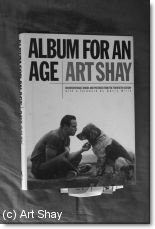
Marlon Brando © Art Shay |
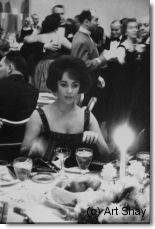
Liz Taylor © Art Shay |
In 1960, I photographed Liz Taylor for Life, and a few weeks later drew her as my seatmate on a TWA plane out of L.A. "Art," she said with a twinkle, "I had a tough party last night. How about we don't talk and just sleep together all the way to Chicago."
In the Seventies, Time Magazine sent me to Minnesota to photograph a great young actress who had just co-starred in a remake of King Kong. We hit it off very well.
Thus it was that she let me pick her up in imitation of Kong and carry her off. Her girlfriend shot us with my Leica.
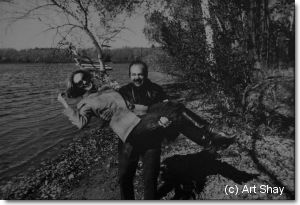
Lange & Shay
© Art Shay
Just now the movie makers are looking at the snapshots of my life, my peregrinations in Chicago and Paris, and of course, through my extensive pictures of Nelson Algren and his on-again-off-again affair with his world class bisexual nympho of a Madame, Simone, who in the heat of sex -- some of which had resulted in her very first orgasm, Sartre, Camus, Colette, and Piaf notwithstanding -- promised Nelson she would move to Chicago and be his Chicago housewife -- a side of her that French feminists have always found uncomfortable, even impossible, to examine. Algren called her a try-sexual.
Unlike the Jewish circumciser mohls I have observed at brisses all over the world, I will not have final cut on my movie. This, of course, makes me nervous. Editors -- movie and text -- all have a built-in trope of Photoshop and do not hesitate to exercise it.
What brings my movie to mind is a documentary I recently saw about the ten days leading up to D-Day, June 6, 1944. My D-Day in my war, when I was 22. The film was a clever amalgam of ancient footage and a pretty good re-enactment. The Canadian kid, whom you know will get it, is followed nicely. The German commander, Von Rumstedt, is shown taking D-Day off because of his lousy weather corps, informing him the invasion couldn't possibly take place because of the lows in the area.
A double agent helped our cause, I learned, telling the Germans we'd probably hit Norway and telling us to go for it. I went for it twice on D-Day, hitting Nazi gun emplacements just beyond the beach, and a few hours later, bombing the shit out of the Rennes railroad yards. (I would learn later that Hitler had visited Rennes that day and we'd almost gotten the bastard!) As Osama bin Laden would say to Al Jazeera at cave-mouth, "'Almost' doesn't count you Black Satan mother fuckers."
Suddenly, there in a London cab going in to brief Churchill on June 4, was an old friend -- a comrade in arms -- Brigadier General Donald Yates! His simulacrum actor was tall and chubby -- looking nothing like the short, suave Yates. I would eventually fly as Yates's navigator in an Air Transport Command flight from Washington to Bermuda. This was a favorite run for Pentagon generals because it was just over four hours in propeller-driven DC4s. We officers needed to fly at least four hours a month to get our 50% bonus of flight pay. Thus we would embark on the 29th or 30th of a month and return on the 2nd or 3rd -- two months' flying pay in our kits! But I digress. It was Yates who bravely predicted that his data indicated the weather would clear on the morrow, and thus General Ike gave us the go sign. I was in the cockpit with Yates one Bermuda mission when he got the call from the Pentagon -- the Air Force had just given him his second star. I saluted him smartly -- the first he received as a Major General -- and I salute him now, wherever he's moldering. But who is left to apologize for letting some inadequate actor fill his golden shoes? Movies!
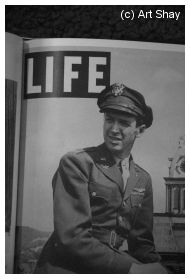
In 2001, a wonderful Chicago actor named John Sterchi, fresh from playing a hood in some hit Mafia film, played me for a whole month in my autobiographical play about WW2, "Where Have You Gone, Jimmy Stewart?" Stewart was my squadron commander. We never flew together, but, as I noted in my play, I was on the stupid team that built and fired a mini V-2 rocket on our air base that narrowly missed killing Colonel Stewart. It landed in a noisy mess on the roof of the Officer's Mess and trickled down in hot metal disarray to his feet.
Always conscious of his audience Stewart wasn't as much miffed about our prank as concerned about its effect. "Can you imagine the headlines?" he asked me angrily. "Famous actor killed on American air base by toy rocket?"
We both laughed nervously, which I suppose is the only way to react to drama in everyday life, with or without cameras turning.
At 3 a.m. last night, just after I sent all of the above off to my editor, Gilles d'Aymery, straight into his disgruntled Californiashment at the yet-again disorganization of my words and pictures for Swans, there on my new HDTV was a documentary on master moviemaker Federico Fellini.
The grotesquely fat genius was full of years and cinematic philosophy, (the gist: "I always need an enemy to make a good movie -- someone, something to goad me into action... I never wait for inspiration. I make movies because I sign contracts to do them. If I waited for inspiration... etc."). I was enthralled by his esthetic tyranny on the set. He ordered up waves of white plastic to spread on a patch of ocean to make it look more like his idea of what an ocean should look like! Merely to serve as a more sea-like background for one of his two-shots.
Out-Neptuning the restless Sea God, Fellini's crew built frames resembling Wright brothers' wings with a crew of strong Italians turning the control spindles that made the wood and plastic roll and roil for his Swiss Arriflexes. The contrivances lay there on the surface moving rhythmically atop the calmer real sea off the bleak Italian coast. So what if nature needed help achieving Fellini's filmic notion of seaworthiness.
One-upping the sea for realer reality lent calming credence to what I learned from the Master early this a.m.: Cinema is the art of using fakery (his word) to make life's real dreams come true.
At first I was concerned about what the filmmakers will do to my book and Algren -- thinking what the hell, Algren died in 1981 and my nude picture of his lover, Simone de Beauvoir, wasn't a magazine cover until recently -- I now realize that I may be in the middle of a maelstrom. Who knows where cinematography will take my work in its quest for Fellini-like actuality?
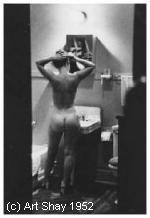
As The New Yorker put it a few months ago, "...France was disrupted by the image of a woman both sexually alive and politically relevant -- defiant and proud and threatening. And while that was going on the president of the country was canoodling with a former model. [...] The picture was taken in 1950, by, of all people, an American -- the photographer Art Shay -- in, of all places, Chicago, where Beauvoir was canoodling bilingually with Nelson Algren." Awash in more seas of comas, the article also dragged in Henry Miller, Anais Nin, Mick Jagger, Donald Trump, Princess Di, Bill Clinton, Tom Cruise, Oprah, Tony Blair, and former French President Mitterrand. It, after all, purported to be a view of the world's changing sexual morality precipitated by my simple nude picture of the world's premier feminist and author of The Second Sex, partly hatched hereabouts at Algen's ten-buck apartment at 1523 Wabansia.
It's a beautiful Chicago (of all places) morning, so I think I'll wander down to the Art Institute near Lake Michigan and brood about how Fellini would use my pictures of Algren owned by that august repository. How they might be juxtaposed with the beloved lake that figured so greatly in our lives and that of Simone de Beauvoir, who, despite The New Yorker's flip inaccuracy, canoodled with Algren only in English because he was monolingual.
I'd hope my movie maker would be more truthful and wouldn't fuck around with the lake whose calmness I find soothing against the backdrop of my turbulent still pictures.
If you find our work valuable, please consider helping us financially.